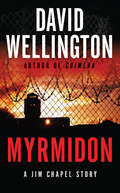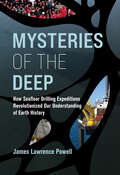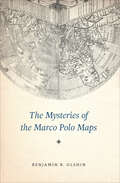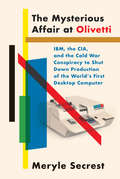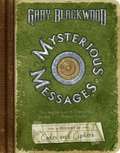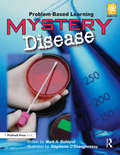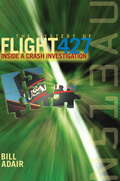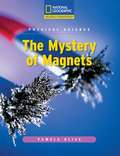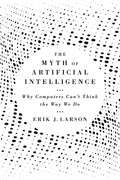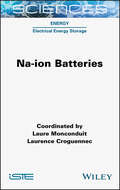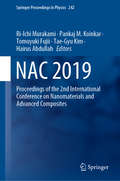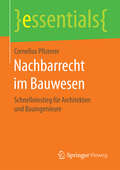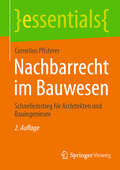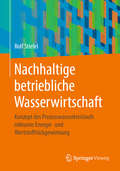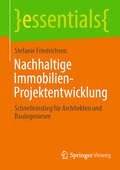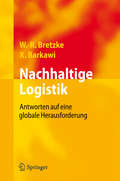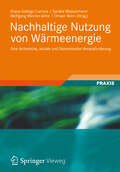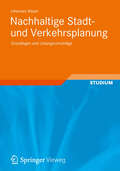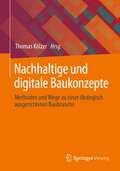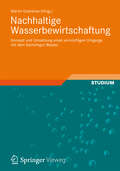- Table View
- List View
Myrmidon
by David WellingtonAn e-book original action thriller by acclaimed author David Wellington. Wounded Special Forces veteran Jim Chapel now specializes in missions improbable (and sometimes impossible). After confronting a Russian triple agent, Chapel must infiltrate a separatist militia group to track and seize contraband Russian weaponry. But the militia leader has his own agenda . . . and an ace up his sleeve.
Mysteries of the Deep: How Seafloor Drilling Expeditions Revolutionized Our Understanding of Earth History
by James Lawrence PowellA groundbreaking chronicle of scientific ocean drilling—a crowning achievement of the twentieth century—and how it shaped our knowledge of Earth's past.Under the radar—or, rather, sonar—of most people and many scientists, for the last six decades ships have plied the world&’s oceans, mining the seafloor for its secrets—and quietly resolving confounding geological mysteries. Continental drift and plate tectonics. The origin of the Hawaiʻian Islands. The erstwhile disappearance of the Mediterranean. The mystery of the ice ages. All are part of the story told by deep-sea drilling—and chapters in the history that unfolds in Mysteries of the Deep. In a series of vignettes ranging from the voyage of the HMS Challenger in the 1870s to the adventures of research ship Chikyū in the 2020s, James Powell recounts the surprises the seafloor has yielded to the probing of scientists.With a global, sometimes even extraterrestrial scope and a scientific reach that extends to every corner of geology and astrobiology, Powell&’s work recounts how cores extracted from the ocean floor have:· produced insights into microbial life on Mars and the end of dinosaurs&’ tenure on Earth· demonstrated that astronomical cycles control many geological events, and even human evolution· used a past episode of global warming to reveal the peril of high temperatures today· shown that global warming could melt enough Antarctic ice to drown the seacoastsThe mysteries uncovered by deep-sea drilling, and covered by Powell in this eye-opening book, are many and various, often surprising and sometimes alarming—consequential not just for the science of the seafloor, but for how we learn about our planet's past and what we can do about its future.
The Mysteries of the Marco Polo Maps
by Benjamin B. OlshinWhat&’s the truth behind the travels of Marco Polo? &“A fascinating tale about maps, history and exploration.&”—Times Literary Supplement (UK) In the thirteenth century, Italian merchant and explorer Marco Polo traveled from Venice to the far reaches of Asia, a journey he chronicled in a narrative titled Il Milione, later known as The Travels of Marco Polo. While Polo&’s writings would go on to inspire the likes of Christopher Columbus, scholars have long debated their veracity. Some have argued that Polo never even reached China—while others believe that he came as far as the Americas. Now, there&’s new evidence for this historical puzzle: a very curious collection of fourteen little-known maps and related documents said to have belonged to the family of Marco Polo himself. Here, historian of cartography Benjamin B. Olshin offers the first credible book-length analysis of these artifacts, charting their course from obscure origins in the private collection of Italian-American immigrant Marcian Rossi in the 1930s; to investigations of their authenticity by the Library of Congress, J. Edgar Hoover, and the FBI; to the work of the late cartographic scholar Leo Bagrow; to Olshin&’s own efforts to track down and study the Rossi maps, all but one of which are in the possession of Rossi&’s great-grandson. Are the maps forgeries, facsimiles, or modernized copies? Did Marco Polo&’s daughters—whose names appear on several of the artifacts—preserve in them geographic information about Asia first recorded by their father? Or did they inherit maps created by him? Did Marco Polo entrust the maps to an admiral with links to Rossi&’s family line? Or, if the maps have no connection to Marco Polo, who made them, when, and why? Regardless of the maps&’ provenance, this tale takes us on a fascinating journey, offering insights into Italian history, the age of exploration, and the wonders of cartography. &“Olshin&’s book tugs powerfully at the imagination of anybody interested in the Polo story, medieval history, old maps, geographical ideas, European voyages of discovery, and early Chinese legends.&”—The Wall Street Journal
The Mysterious Affair at Olivetti: IBM, the CIA, and the Cold War Conspiracy to Shut Down Production of the World's First Desktop Computer
by Meryle SecrestThe never-before-told true account of the design and development of the first desktop computer by the world's most famous high-styled typewriter company, more than a decade before the arrival of the Osborne 1, the Apple 1, the first Intel microprocessor, and IBM's PC5150.The human, business, design, engineering, cold war, and tech story of how the Olivetti company came to be, how it survived two world wars and brought a ravaged Italy back to life, how after it mastered the typewriter business with the famous "Olivetti touch," it entered the new, fierce electronics race; how its first desktop compter, the P101, came to be; how, within eighteen months, it had caught up with, and surpassed, IBM, the American giant that by then had become an arm of the American government, developing advanced weapon systems; Olivetti putting its own mainframe computer on the market with its desktop prototype, selling 40,000 units, including to NASA for its lunar landings. How Olivetti made inroads into the US market by taking control of Underwood of Hartford CT as an assembly plant for Olivetti's own typewriters and future miniaturized personal computers; how a week after Olivetti purchased Underwood, the US government filed an antitrust suit to try to stop it; how Adriano Olivetti, the legendary idealist, socialist, visionary, heir to the company founded by his father, built the company into a fantastical dynasty--factories, offices, satellite buildings spread over more than fifty acres--while on a train headed for Switzerland in 1960 for supposed meetings and then to Hartford, never arrived, dying suddenly of a heart attack at fifty-eight . . . how eighteen months later, his brilliant young engineer, who had assembled Olivetti's superb team of electronic engineers, was killed, as well, in a suspicious car crash, and how the Olivetti company and the P101 came to its insidious and shocking end.
Mysterious Messages: A History of Codes and Ciphers
by Gary BlackwoodHistory?s amazing secrets and codes?and how to crack them yourself. This fascinating look at history?s most mysterious messages is packed with puzzles to decode and ciphers that kids can use themselves. Here are the encrypted notes of Spartan warriors, the brilliant code-crackers of Elizabeth I, secret messages of the American Revolution, spy books of the Civil War, the famous Enigma Machine, and the Navajo code talkers. As computers change the way we communicate, codes today are more intriguing than ever. From invisible ink to the CIA, this exciting trip through history is a hands-on, interactive experience? so get cracking!
The Mysterious Mr. Nakamoto: A Fifteen-Year Quest to Unmask the Secret Genius Behind Crypto
by Benjamin WallaceA thrilling investigation into the mysterious identity of Bitcoin&’s creator and a deep dive into crypto&’s utopian origin story—from The New York Times bestselling author of The Billionaire&’s Vinegar&“Could be the best mystery story of the past twenty years.&”—James Patterson &“The Mysterious Mr. Nakamoto will leave you amazed, enlightened, and utterly breathless.&”—Robert Kolker, #1 New York Times bestselling author of Hidden Valley RoadIn October 2008, someone going by the name Satoshi Nakamoto posted a white paper outlining &“a peer-to-peer electronic cash system&” called Bitcoin to an arcane listserv populated by Cypherpunks. No one in the community had heard of Nakamoto, and just as people were starting to wonder who he was, he vanished. As the years passed, and the scope of Nakamoto&’s achievement became clear, the truth of his identity grew into the greatest unsolved mystery of our time.The Mysterious Mr. Nakamoto traces Benjamin Wallace&’s attempt to unmask the figure behind the currency and the world it wrought. Nakamoto&’s Bitcoin at first seemed destined to fulfill the dreams of fringe 1990s utopians for a currency set free from governments and big banks. Yet after he disappeared, his creation took on a strange new life in the financial markets, where rampant speculation fueled a vision of crypto as a potential windfall, inviting charlatans and scammers and opening a vast gulf between Bitcoin&’s idealistic origins and its troubled reputation.But who was Nakamoto? Whoever he was could rightly claim to have invented one of the most important technologies of the new century. And Nakamoto was a billionaire—his Bitcoin wallet held an untouched eleven-figure fortune waiting to be claimed.With the same propulsive-narrative flair that made his New York Times bestseller The Billionaire&’s Vinegar an instant success, Benjamin Wallace presents a page-turning work of investigative journalism. Tracking leads from London to Oslo to Los Angeles, from coastal Australia to the Arizona desert, he takes readers through a rogues&’ gallery tour of Nakamoto suspects—from benevolent geniuses like cryptographer Hal Finney to difficult ones like a reclusive polymath known to his followers only as Jim; from the mercurial Australian Craig Wright, who claims to be Nakamoto, to a secret team at the National Security Agency. With the forensic skill of Sherlock Holmes and the storytelling verve of Arthur Conan Doyle, Wallace follows the trail of computer code and personal writings to the heart of the Nakamoto mystery while interrogating the very nature of mystery itself.
Mystery Disease: Problem-Based Learning (Grades 5-8)
by Mark A. BohlandA serious illness is sweeping through town. Why are people getting sick? What is the source of this disease? With this problem-based learning unit, students become public health workers as they track down the source of a mysterious illness. Working in teams to solve the real-world problem and present their findings, they experience genuine, higher order learning. Decisions they make affect the outcome of the simulation.The activities combine science, social studies, math, research, thinking, cooperation, and speech skills in one great unit. This guide includes everything you need—teacher's directions and student information in the form of memos and medical reports.This open-ended scenario will draw students into a real-life drama.Allow your students to solve more real-life problems in Crime Scene Detective, Detective Club, Mystery Science, and The Great Chocolate Caper.Grades 5-8
The Mystery of Flight 427
by Bill AdairThe immediate human toll of the 1994 Flight 427 disaster was staggering: all 132 people aboard died on a Pennsylvania hillside. The subsequent investigation was a maze of politics, bizarre theories, and shrouded answers. Bill Adair, an award-winning journalist, was granted special access to the five-year inquiry by the National Transportation Safety Board (NTSB) while its investigators tried to determine if the world's most widely used commercial jet, the Boeing 737, was really safe. Their findings have had wide-ranging effects on the airline industry, pilots, and even passangers. Adair takes readers behind the scenes to show who makes decisions about airline safety--and why.
The Mystery of Magnets
by Pamela BlissDescribes how magnets act on objects and other magnets. Explains how Earth is a magnet. Identifies historical discoveries about magnetism. Explores the relationship between electricity and magnetism.
The Mystery of the Aleph
by Amir D. AczelThe history of infinity emphasizing the people who were interested in the concept. Stresses philosophical and religious importance of mathematical ideas throughout history. Fascinating even if math is not your strong suit.
The Mystery of the Black Hole Mine (D. J. Dillon Adventure #7)
by Lee RoddyD.J. gets a bad case of "gold fever" when he and Alfred accidentally discover an abandoned-- and mysteriously dangerous-- gold mine.
The Myth of Artificial Intelligence: Why Computers Can't Think the Way We Do
by Erik J. Larson“Artificial intelligence has always inspired outlandish visions—that AI is going to destroy us, save us, or at the very least radically transform us. Erik Larson exposes the vast gap between the actual science underlying AI and the dramatic claims being made for it. This is a timely, important, and even essential book.” —John Horgan, author of The End of Science Many futurists insist that AI will soon achieve human levels of intelligence. From there, it will quickly eclipse the most gifted human mind. The Myth of Artificial Intelligence argues that such claims are just that: myths. We are not on the path to developing truly intelligent machines. We don’t even know where that path might be. Erik Larson charts a journey through the landscape of AI, from Alan Turing’s early work to today’s dominant models of machine learning. Since the beginning, AI researchers and enthusiasts have equated the reasoning approaches of AI with those of human intelligence. But this is a profound mistake. Even cutting-edge AI looks nothing like human intelligence. Modern AI is based on inductive reasoning: computers make statistical correlations to determine which answer is likely to be right, allowing software to, say, detect a particular face in an image. But human reasoning is entirely different. Humans do not correlate data sets; we make conjectures sensitive to context—the best guess, given our observations and what we already know about the world. We haven’t a clue how to program this kind of reasoning, known as abduction. Yet it is the heart of common sense. Larson argues that all this AI hype is bad science and bad for science. A culture of invention thrives on exploring unknowns, not overselling existing methods. Inductive AI will continue to improve at narrow tasks, but if we are to make real progress, we must abandon futuristic talk and learn to better appreciate the only true intelligence we know—our own.
Na-ion Batteries
by Laure Monconduit Laurence CroguennecThis book covers both the fundamental and applied aspects of advanced Na-ion batteries (NIB) which have proven to be a potential challenger to Li-ion batteries. Both the chemistry and design of positive and negative electrode materials are examined. In NIB, the electrolyte is also a crucial part of the batteries and the recent research, showing a possible alternative to classical electrolytes – with the development of ionic liquid-based electrolytes – is also explored. Cycling performance in NIB is also strongly associated with the quality of the electrode-electrolyte interface, where electrolyte degradation takes place; thus, Na-ion Batteries details the recent achievements in furthering knowledge of this interface. Finally, as the ultimate goal is commercialization of this new electrical storage technology, the last chapters are dedicated to the industrial point of view, given by two startup companies, who developed two different NIB chemistries for complementary applications and markets.
NAC 2019: Proceedings of the 2nd International Conference on Nanomaterials and Advanced Composites (Springer Proceedings in Physics #242)
by Ri-Ichi Murakami Pankaj M. Koinkar Tomoyuki Fujii Tae-Gyu Kim Hairus AbdullahThis book presents selected articles from the 2nd International Conference on Nanomaterials and Advanced Composites, which brings together leading researchers and professionals from academia and industry to present their findings and provides a platform for the exchange of ideas and future collaboration. The book covers eight topics, including nanomaterials, polymer materials, mechanical materials, materials chemistry, materials physics, ceramics, recycling materials and green composites.
Nachbarrecht im Bauwesen: Schnelleinstieg für Architekten und Bauingenieure (essentials)
by Cornelius PfistererCornelius Pfisterer erkl#65533;rt die Grundbegriffe zum Grundst#65533;cks- und Nachbarrecht und zeigt auf, was der Nachbar bei einem Bauvorhaben dulden muss und was er abwehren kann. In diesem essential erfahren Sie, wie das Hammerschlags- und Leiterrecht zugunsten des Bauherrn auch formal richtig geltend zu machen ist. Wichtige Unterschiede zwischen #65533;ffentlichem und privatem Recht werden erl#65533;utert. Praktische Hinweise zur Gestaltung einer Nachbarvereinbarung erg#65533;nzen die Darstellung der Rechtsgrundlagen. Wer sich hier nicht auskennt, riskiert gerade bei innerst#65533;dtischen Bauvorhaben aufgrund nachbarlicher Einwendungen erhebliche Bauverz#65533;gerungen, Planungs#65533;nderungen und Mehrkosten. Hier finden Sie die rechtlich-formalen L#65533;sungen, wenn bspw. eine Unterfangung des Nachbargeb#65533;udes erforderlich wird, W#65533;rmed#65533;mmma#65533;nahmen im Bestand geplant sind oder ein Baukran das Nachbargrundst#65533;ck #65533;berschwenken muss.
Nachbarrecht im Bauwesen: Schnelleinstieg für Architekten und Bauingenieure (essentials)
by Cornelius PfistererDieses essential vermittelt Ihnen die Grundbegriffe zum Grundstücks- und Nachbarrecht. Sie erfahren, was der Nachbar bei einem Bauvorhaben dulden muss und was er abwehren. Es wird erläutert, wie das Hammerschlags- und Leiterrecht zugunsten des Bauherrn auch formal richtig geltend zu machen ist. Wichtige Unterschiede zwischen öffentlichem und privatem Recht werden erklärt. Praktische Hinweise zur Gestaltung einer Nachbarvereinbarung ergänzen die Darstellung der Rechtsgrundlagen. Wer sich hier nicht auskennt, riskiert gerade bei innerstädtischen Bauvorhaben aufgrund nachbarlicher Einwendungen erhebliche Bauverzögerungen, Planungsänderungen und Mehrkosten. Hier finden Sie die rechtlich-formalen Lösungen, wenn eine Unterfangung des Nachbargebäudes erforderlich wird, Wärmedämmmaßnahmen im Bestand geplant sind oder ein Baukran das Nachbargrundstück überschwenken muss. In der 2., überarbeiteten Auflage wurden zahlreiche gesetzliche Neuerungen berücksichtigt und aktuelle Rechtsprechung eingepflegt.
Nachhaltige betriebliche Wasserwirtschaft: Konzept des Prozesswasserkreislaufs inklusive Energie- und Wertstoffrückgewinnung
by Rolf StiefelDarstellung der sich verschärfenden Anforderung hinsichtlich Wassergewinnung, höhere Anforderung bei der Abwassereinleitung sowie der Preisdruck bei Energie- und Rohstoffen. Lösungsmöglichkeiten für Industriebetriebe durch wassersparende Produktion, Abwasserrecycling, Rohstoffrückgewinnung, Regenwassernutzung und energieeinsparung.
Nachhaltige Entwicklung technischer Produkte und Systeme: Der Ingenieurberuf im Wandel
by Jürgen H. FranzDas Buch erläutert ausgehend vom Begriff der Nachhaltigkeit die Anforderungen an die Herstellung technischer Systeme. Es erklärt die Lebensphasen eines Produktes, die Rolle der Nachhaltigkeit in diesen Phasen und die sich daraus ergebenden Konsequenzen für den Ingenieur und die Ingenieurin sowie für die Ausbildung in den ingenieurwissenschaftlichen Studiengängen. Das Buch zeigt, dass durch die Anforderungen, welche die Nachhaltigkeit setzt, der Ingenieurberuf noch vielseitiger und spannender, aber auch verantwortungsvoller wird, als er ohnehin schon ist.
Nachhaltige Immobilien-Projektentwicklung: Schnelleinstieg für Architekten und Bauingenieure (essentials)
by Stefanie FriedrichsenDieses Essential beleuchtet die zentralen Aspekte und Abläufe bei der Entwicklung nachhaltiger Immobilien. Von der Zustandsanalyse über die Projektidee bis hin zur Wirtschaftlichkeitsanalyse werden wichtige Schritte und Konzepte erläutert, um eine langlebige, ökologische und sozialverträgliche Immobilie zu gestalten, die zugleich wirtschaftlichen Erfolg verspricht.
Nachhaltige Logistik
by Karim Barkawi Wolf-Rüdiger BretzkeDie Reduzierung von Schadstoffemissionen, Ölpreissteigerungen und eine überlastete Verkehrsinfrastruktur haben die Rahmenbedingungen der Logistik in den letzten Jahren völlig verändert. Die aktualisierte Neuauflage des Werks greift die Änderungen in der Umweltpolitik auf, die den Kontext unternehmerischer Entscheidungen bestimmen. Anpassungsstrategien werden vorgestellt und Themen wie Kreislaufwirtschaft, Prozess- und Netzwerkredesign, Citylogistik und Globalisierung anhand einer deutlich erhöhten Anzahl von Graphiken und Praxisbeispielen erörtert.
Nachhaltige Nutzung von Wärmeenergie: Eine technische, soziale und ökonomische Herausforderung
by Diana Gallego Carrera, Sandra Wassermann, Wolfgang Weimer-Jehle and Ortwin RennDas Buch gibt Antworten auf die Frage, wie Wärmeenergie in Privathaushalten nachhaltig genutzt werden kann. Hierzu wird das Thema entlang des Dreiklangs von Suffizienz-, Konsistenz- und Effizienzstrategien interdisziplinär beleuchtet. Die Autoren zeigen sowohl von der Wärmeenergienutzerseite, als auch von der technologischen Seite Anreize und Hemmnisse für eine nachhaltige Nutzung der Wärmeenergie in Privathaushalten auf. Die umfassende und interdisziplinäre Darstellung des Themas bietet sowohl Nutzern als auch Fachleuten einen umfassenden Einblick in das Themenfeld der Wärmeenergienutzung in Privathaushalten.
Nachhaltige Rückbau- und Entsorgungsplanung: Erarbeitung eines Rückbau- und Entsorgungskonzeptes im Bereich des Einzelhandels (Entwicklung neuer Ansätze zum nachhaltigen Planen und Bauen)
by Jonas ScharkeDas Buch beschreibt die Herangehensweise an die Entsorgung- und den Rückbau im Einzelhandel unter vorrangig ökologischen Gesichtspunkten. Hierbei stehen die Strukturierung und die Ablaufplanung des Rückbaus im Kontext der Einzelhandelsexpansion im Fokus. Dies umfasst die Darstellung und Berücksichtigung auftretender Besonderheiten sowie hieraus entwickelte Lösungsvorschläge im praktischen Umgang. Das entstehende Konzept dient dabei als Wegweiser für Unternehmen, perspektivisch nachhaltige Aspekte in der Rückbauplanung zu manifestieren.“
Nachhaltige Stadt- und Verkehrsplanung
by Johannes MeyerAusgehend von den Grundlagen des Städtebaus beschäftigt sich dieses Buch mit dem besonderen Aspekt der Nachhaltigkeit in der aktuellen Stadt- und Verkehrsentwicklung und dem Umgang mit bestehenden städtebaulichen Strukturen. Die Themen Demographischer Wandel, Energieeinsparung, Umwelt- und Klimaschutz stehen dabei im Fokus. Es enthält sowohl grundlegende Informationen als Einstieg in die Thematik als auch konkrete Beispiele aus der Praxis.
Nachhaltige und digitale Baukonzepte: Methoden und Wege zu einer ökologisch ausgerichteten Baubranche
by Thomas KölzerIn Anbetracht der Auswirkungen des Klimawandels auf unsere Umwelt müssenbestehende Prozesse in vielen Bereichen unserer Gesellschaft überdacht werden.Damit einhergehend ist es wichtig, innovative und vor allem auch ökologische Konzeptevermehrt in den Fokus zu rücken. Da die Baubranche einen massiven Anteilan den negativen Effekten auf unsere Umwelt hat, liegt es nahe, erfolgsversprechendeAnsätze genau in diesem Bereich ausfindig zu machen. Mithilfe digitaler Konzeptesind verschiedene Zusammenhänge so modifizierbar, dass Abläufe nicht nureffektiver, sondern insbesondere auch nachhaltiger werden. So stellt sich im Hinblickauf die anstehenden Herausforderungen infolge des Klimawandels die Frage,welche zusätzlichen Potenziale sich durch innovative Herangehensweisen ergeben.Das vorliegende Sammelwerk präsentiert diesbezüglich aktuelle und zukunftsweisendeKonzepte aus verschiedenen Bereichen der Baubranche.
Nachhaltige Wasserbewirtschaftung
by Alois Heissenhuber Andreas Goetz Anton Steiner Bernd Scherer Christiane Groß Christine Krämer Christine Wenzel Claus Kumutat Dietmar Wienholdt Erich Eichenseer Erich Englmann Gabriele Merz Gregor Overhoff Hans Huber Holger Magel Ingo Reimann Jacobus Hofstede Jakob Opperer Karl Schneider Katrin Horn Maria Patek Martin Faulstich Martin Grambow Martin Steger Martin Wahl Michael Becker Michael Haug Peter Rutschmann Peter Wilderer Raoul Weiler Reinhard F. Schmidtke Rolf Manser Stephan Von Keitz Theo Schlaffer Ulrich Drost Walter Binder Werner Reifenhäuser Werner Wahliß Wolfgang Günthert Wolfram MauserDer Wassersektor gehört zu den ganz großen aktuellen globalen Herausforderungen. Wasserbewirtschaftung verlangt ein vertieftes Verständnis der Nachhaltigkeit. Das Buch erläutert vor diesem Hintergrund Theorie und Praxis des integrierten Managements. Es erklärt politische und technische Grundlagen des Wassermanagements und entwirft einen praxisnahen modularen Lösungsansatz, der eine erfolgreiche Bewirtschaftung des Wasserschatzes erleichtert.
